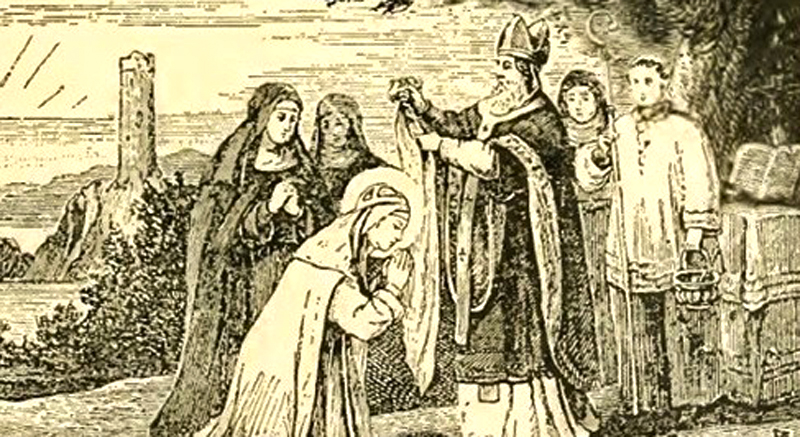(453-523)
Bridgid was born in Fochard, province of Ulster Ireland. It is said that when she was just an infant her father had a vision of men clothed in white garments pouring a sacred unguent on her head, thus prefiguring her future sanctity.
Even as a youngster she dedicated herself to God, bestowed everything at her disposal on the poor, and was a treasure to all who knew her.
Legends abound about Bridgid. It was said that one day the people of the area saw that the house in which the child Brigid was living was on fire. They rushed to the house to put out the flames but found on arrival that there was no fire at all. They concluded that the child was filled with the Holy Spirit. Once, while asleep, the druid priest saw three clerics, or three angels, coming and pouring oil on Brigid’s head to complete the rite of baptism. The three clerics instructed the druid to give the name Brigid to the child.
Brigid was not accustomed to take the ordinary food available to her. For this reason, the druid obtained a white cow with red ears and she used to drink the milk of this cow. As Brigid grew up everything under her care increased and flourished. She took care of the sheep, of blind people and of the poor.
Refusing many good offers of marriage, she became a nun and received the veil from St. Macaille. With seven other women she settled for a time at the foot of Croghan Hill and later moved to Druin Criadh, in the plains of Magh Life, where under a large oak tree she erected the famous Convent of Cill-Dara, that is, “the church of the oak” (now Kildare), in the present county of that name.
Bishops, priests, and chieftains sought her counsel, and she was so beloved that she became known as “The Mary of the Gaels.” A common blessing became “Brigid and Mary be with you.”
St. Bridgid died after 70 years devoted service. During that time, her holy institute had become widely diffused throughout Ireland and had greatly advanced the cause of religion in the various districts where it was established. When she died, her body was interred in the church adjoining her convent, but later was exhumed and deposited in a splendid shrine near the high altar, afterward to be moved again and placed in the same grave with the relics of St. Patrick. Their holy remains, together with those of St. Columba, were translated afterwards to the cathedral church of Kildare.
St. Brigid, affectionately known as “Bride,” “Bridey” or “the Mary of the Gael,” is the patroness of dairy maids, infants, midwives, blacksmiths, poets, nuns and students. Along with Sts. Patrick and Columba (Columcille), she is the patroness of Ireland. In Ireland today, after 1,500 years, the memory of “the Mary of the Gael” is as dear as ever to the hearts of the Irish people.
Brigid is also popular as a female Christian name. Moreover, hundreds of placenames in her honor are to be found all over Ireland, e.g., Kilbride, Brideswell, Tubberbride, Templebride, etc. The hand of St. Brigid is preserved at Lumiar near Lisbon, Portugal, since 1587, and another relic is at St. Martin’s, Cologne.
Adapted by A. J. Valentini from: Editor Staff. (2019, Feb. 1). St. Bridgid of Ireland, Abbess. Regina Foundation of Oregon. https://www.reginamag.com/saint-bridgid-ireland-abbess/
